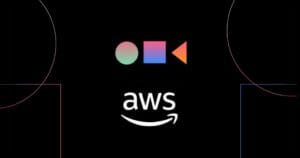5 Successful Email Newsletters You Can Learn From
Key Takeaways
- Consistency, novelty, and design are key to creating an engaging newsletter, as demonstrated by Maple’s daily food menu emails. The predictability of the format, combined with the ever-changing menu items, keeps subscribers interested and engaged.
- InsideHook’s newsletter success is attributed to its entertaining yet educational content, which appeals to a wider audience. It also lessens the promotional feel by including interesting pieces from around the web, not just their own articles.
- Brilliant.org’s newsletter stands out by making it interactive, giving subscribers a reason to click through to their site. This approach transforms readers from passive to active participants, stimulating their curiosity and engagement.
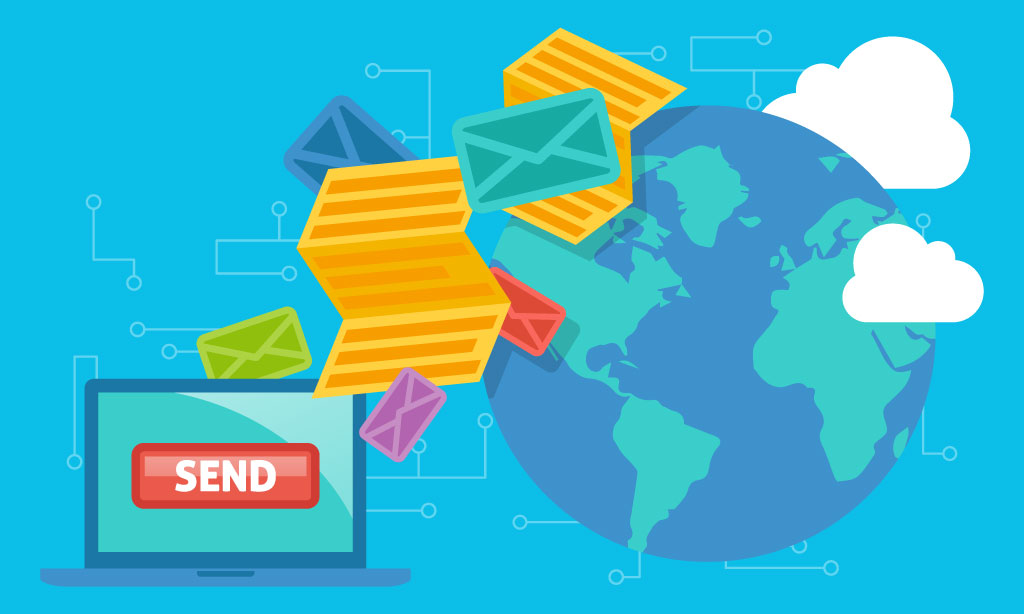
Starting a newsletter is pretty easy, thanks to tools like Mailchimp, Benchmark Email, and Constant Contact. But starting a newsletter that people actually want to read? That’s much harder.
First, we’ll show you five examples of well-executed email newsletters. Then, we’ll dive into which model is best for your specific goals and product.
Example 1: Maple
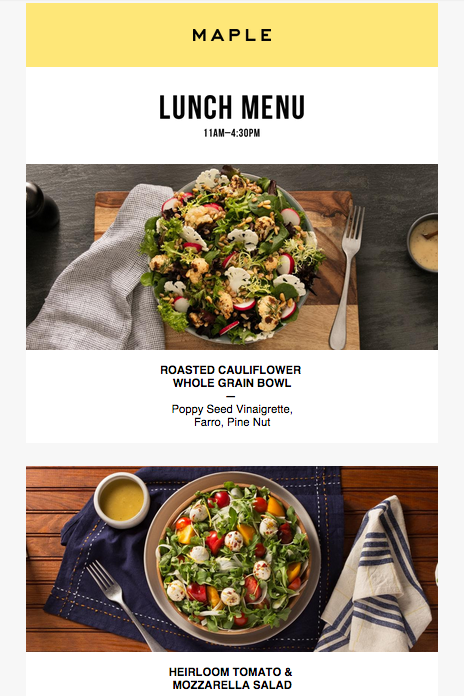
Maple is a gourmet food delivery service. The lunch and dinner menus are small—think three or four items each—and change everyday.
Rather than expecting people to proactively go to the Maple site, check out the options, and place an order, Maple’s newsletter does all the work for them.
Each day, at 11:15 AM, Maple sends its customers an email titled: “Today’s Lunch Menu: [Date] at Maple].” The same email goes out at 5:15 PM—except it’s called “Today’s Dinner Menu: [Date] at Maple,” and now lists the dinner options.
Takeaways:
- Be consistent. The send time, title, and design of the Maple newsletter never change, which means customers know exactly what to expect.
- Make it novel. Despite the unchanging details, one thing does vary: the food. Even if they’re not planning on ordering anything, people are curious to know what’s being served.
- Put an emphasis on design. From the high-quality photos to easy-to-read text, reading this newsletter is a pleasurable experience.
Example 2: InsideHook
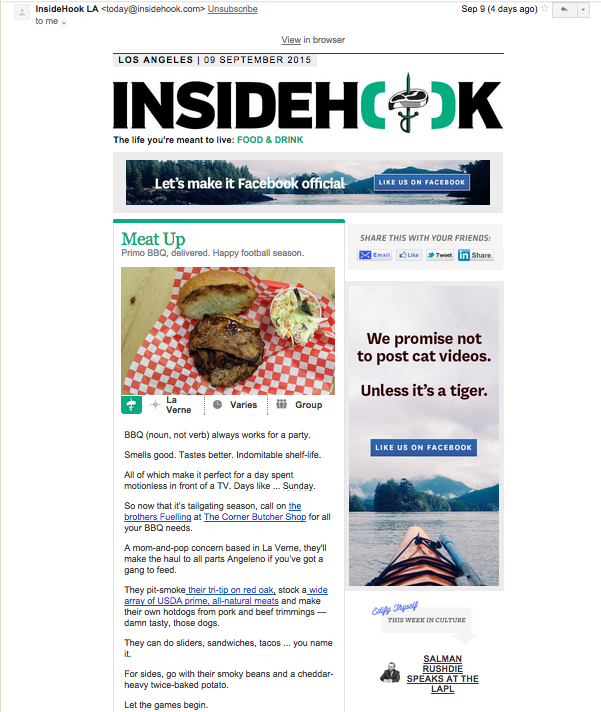
InsideHook is a “city guide for adventurous and established men”—so why do I, a twenty-something college student living in a small town, subscribe to its email? Simple: It’s a really awesome newsletter.
Each daily edition strikes the perfect balance between humorous (check out the title of the September 9th email, “We have an important tailgating announcement”) and useful (“How to Navigate the Airport at Breakneck Speed.”)
Interestingly, InsideHook doesn’t just link to its own articles. The newsletter highlights interesting, timely pieces from around the web.
Takeaways:
- The entertaining/educational split is a guaranteed way to please your readers (which will boost your open and forward rates).
- You can appeal to people outside your target audience by delivering great content.
- If you want to lessen the promotional feeling of your newsletter, bring in outside sources.
Example 3: Brilliant.org

Think of Brilliant as Wikipedia for math, science, and engineering. Its site is worth checking out, but its daily newsletter is truly brilliant.
Around 12:30 AM every night, I get a Brilliant email with a mind-puzzling problem. They’re the kind of problems that you absent-mindedly read—then can’t forget about until you know the answer.
To see the solution, you have to click through to the Brilliant website. From there, it’s super easy to get sucked into a problem-solving binge.
Takeaways:
- Give your email subscribers a reason to click through to your site.
- Make your newsletter interactive. This feature transforms your readers from passive to active participants.
- Arouse your subscribers’ senses of curiosity—whether that’s with a brain-teaser or an intriguing subject line.
Example 4: Levo League
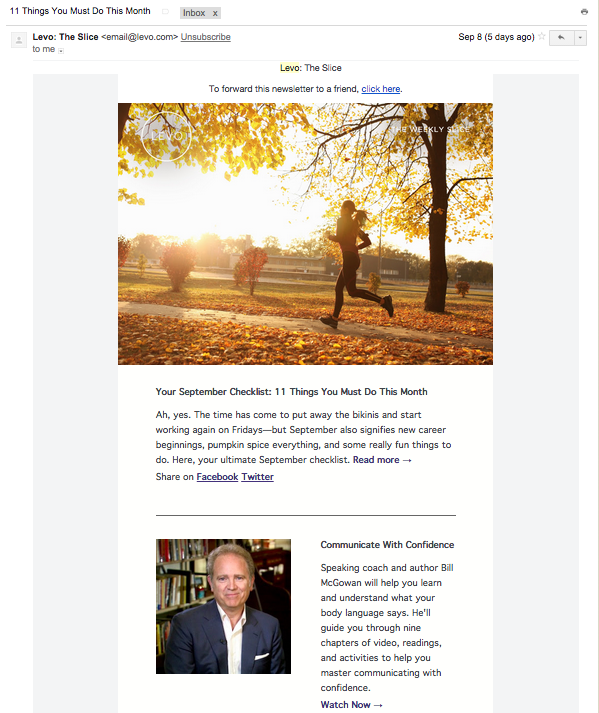
Levo League sends out a ton of newsletters, including Perks (sweepstakes and contests), Announcements, The Brief (a “daily dose” of trending stories), The Slice (a weekly version), Fashionable Fun, and Must Reads.
What’s the rationale behind all these emails? Levo clearly understands that its audience—career women—has diverse interests. By creating niche newsletters for those interests, from fashion and news to pop culture and freebies, the company can serve up personalized content to its users.
Takeaways:
- If there’s a lot of variety in your audience, consider segmenting it so you can send each subset a customized newsletter.
- Similarly, if the topics you want to cover feel too random to belong together in a single newsletter, desegregate them.
- Use your newsletter to make yourself an authority or trusted voice in your space.
Example 5: Skillshare

Skillshare is an online learning community, offering unlimited access to classes like Food Photography: Shooting at Restaurants and Introduction to HTML: Build a Portfolio Website for a monthly fee.
Every couple days, the company sends an email announcing the upcoming live sessions and currently trending classes. This is smart: It encourages people to use the service by continually introducing them to new course, and it also gives its customers the chance to see what others are interested in learning.
Takeaways:
- Use your newsletter to build a sense of community, whether that’s by announcing events, webinars, Twitter chats, etc., by highlighting user activity, or both.
- Create a sense of urgency with a “trending” or “hot right now” feature.
- If you’re using your newsletter to talk about your product, make sure the information is actually valuable to readers.
Picking Your Model
Now that we’ve covered five exemplars and what makes them successful, it’s time to pick the model that’s most suited for your own newsletter.
An easy way to determine the best newsletter to imitate? Pick the one that’s closest to the space you’re in. Here are the newsletters by company category:
- Maple: product/delivery service
- InsideHook: media/lifestyle
- Brilliant: education/entertainment
- Levo League: community/publishing
However, you should also think about the goals you’re trying to accomplish with your newsletter.
Here are some sample goals:
- Alert your customers to new products or product updates
- Develop long-term relationships with your customers
- Build out your brand’s voice
- Incentivize your customers to visit your website
- Drive sales
- Encourage your customer to use your product
So, let’s say you’re most focused on goal no. 1: alerting your users whenever you roll out something new and/or driving sales. The Maple model—a periodic, “here’s what we’ve got” email—is your best bet (although you’ll probably want to reduce the frequency from twice a day to once a week or once a month, depending on your product).
On the other hand, if you’re trying to develop long-term relationships with your users, build out your brand’s voice, and incentivize your users to visit your site, you’d have better luck with the InsideHook or Levo League format.
Alternatively, if you want to encourage your customers to use your product, a newsletter like Brilliant’s would be a smart choice.
And if you can’t decide between two models? Use the marketer’s best friend, A/B tests, to create two newsletter formats and see which one generates more engagement over a two- or three-week period.
Which newsletters do you love? Are there any models you’ve found to be really effective? Let me know on Twitter!
Frequently Asked Questions about Successful Email Newsletters
What makes an email newsletter successful?
A successful email newsletter is one that engages its readers, provides valuable content, and encourages action. It should be visually appealing, easy to read, and contain relevant information that the reader finds useful. The content should be well-written and well-structured, with a clear call to action. It should also be personalized to the reader’s interests and needs, and sent at a frequency that keeps the reader engaged without overwhelming them.
How often should I send my email newsletter?
The frequency of your email newsletter depends on your content and your audience. Some businesses send daily newsletters, while others send weekly, bi-weekly, or monthly newsletters. The key is to find a balance between keeping your readers engaged and not overwhelming them with too many emails. It’s also important to be consistent with your schedule, as readers will come to expect your newsletter at certain times.
How can I increase the open rate of my email newsletter?
There are several strategies to increase the open rate of your email newsletter. First, make sure your subject line is compelling and gives the reader a reason to open the email. Second, personalize your emails as much as possible, as personalized emails tend to have higher open rates. Third, segment your email list so that you can send more targeted emails to different groups of subscribers. Finally, test different send times to see when your subscribers are most likely to open your emails.
What type of content should I include in my email newsletter?
The content of your email newsletter should be relevant to your audience and provide value. This could include industry news, tips and advice, product updates, special offers, and exclusive content. You could also include case studies, customer testimonials, and links to relevant blog posts or articles. The key is to provide content that your readers will find interesting and useful.
How can I make my email newsletter visually appealing?
There are several ways to make your email newsletter visually appealing. First, use a clean and simple design that is easy to read. Second, use images and graphics to break up the text and make the newsletter more engaging. Third, use a consistent color scheme and font style to create a cohesive look. Finally, make sure your newsletter is mobile-friendly, as many people read emails on their phones.
How can I encourage readers to share my email newsletter?
To encourage readers to share your email newsletter, include social share buttons and a “forward to a friend” option in your emails. You could also run a referral program where subscribers get a reward for referring new subscribers. Additionally, make sure your content is high-quality and valuable, as people are more likely to share content that they find useful or interesting.
How can I measure the success of my email newsletter?
There are several metrics you can use to measure the success of your email newsletter, including open rate, click-through rate, conversion rate, and unsubscribe rate. You can also track the number of new subscribers, the number of shares, and the revenue generated from your newsletter. It’s important to regularly review these metrics and adjust your strategy as needed.
How can I grow my email newsletter subscriber list?
There are several strategies to grow your email newsletter subscriber list. First, make it easy for people to subscribe by placing a sign-up form on your website and social media pages. Second, offer an incentive for subscribing, such as a discount or exclusive content. Third, promote your newsletter through your other marketing channels, such as social media, blog posts, and events.
How can I prevent my email newsletter from going to the spam folder?
To prevent your email newsletter from going to the spam folder, make sure you’re following email marketing best practices. This includes using a reputable email service provider, getting permission from subscribers before sending emails, providing a clear unsubscribe option, and avoiding spammy language in your emails. It’s also important to maintain a good sender reputation by regularly cleaning your email list and removing inactive subscribers.
How can I improve the click-through rate of my email newsletter?
To improve the click-through rate of your email newsletter, make sure your content is relevant and valuable to your readers. Use compelling calls to action and make it clear what the reader will get if they click on a link. You can also use A/B testing to test different elements of your email, such as the subject line, content, and design, to see what gets the best results.
Aja Frost is a writer, tech/design geek, and podcast addict. Check out her site or say hi on Twitter.
Published in
·Business·Career Advancement·Email Marketing·Entrepreneur·Entrepreneurship·Entrepreneurship·Freelancing·Marketing·September 4, 2015
